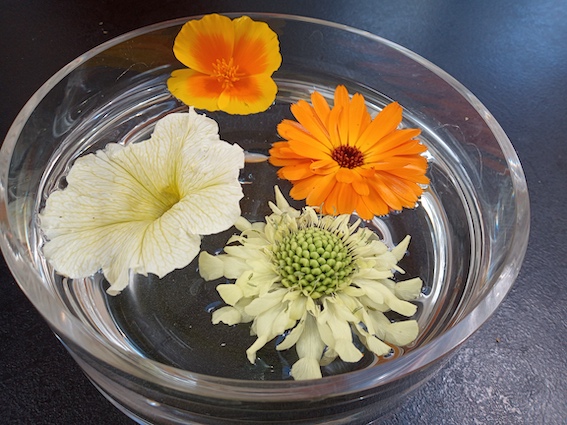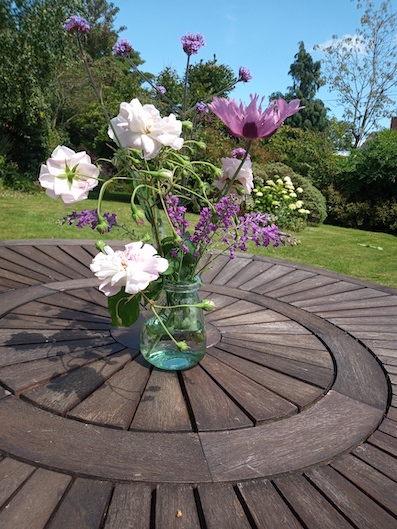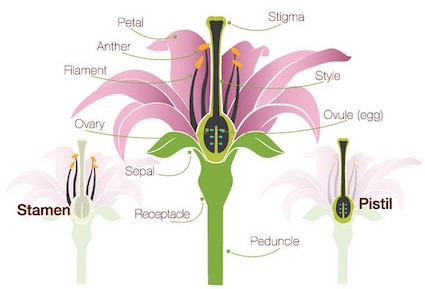
Flowers brighten our world and everybody loves them. But of course that is not their purpose in life. They have evolved as a vehicle for sexual reproduction in plants. Plants can reproduce in other ways, as any gardener knows - for example clumps of perennial plants will gradually expand, some plants (buttercups for example) put out runners which root to form new plants, and the gardener can take cuttings or split off side-bulbs from others. These methods all produce plants which are genetically identical to the parent plant. In contrast, pollination of a flower combines pollen from one plant with what are effectively eggs from another, so that the resulting seeds combine properties from both parents. This has the advantage of introducing variation into the population. Try asking a child if they can think of reasons why variations might be helpful to a plant.
Most children will enjoy collecting flowers from the garden or (in moderation) from nature and displaying them in various ways. Most obviously they can be arranged in a small vase

on a table or windowsill. However, there is something rather magical about flowers floating in a bowl of water. At the same time, children's attention can be drawn to the great variety in the form of flowers. A simple flower - a lily is a good example - has several easily identified components, as shown in the diagram on the left, each of which has a clear role to play.
 The most important features are
the petals, often brightly coloured to attract
pollinating insects, the stamens which carry pollen
in anthers at their tips, and the central stigma
which rises from the ovary beneath. Bees and other
pollinating insects, attracted by the colour and scent of
the flower, and often in search of the sweet nectar
exuded at the base of the flower, brush against the anthers
and become dusted with pollen, which they then transfer to
another flower, where some may be deposited on the stigma.
From here the pollen burrows its way down to the ovary where
it can fertilise one of the eggs contained there, eventually
forming a seed from which a new plant can grow. Children can
be encouraged to watch insects going about the business of
pollination. Can they see the yellow dust of pollen which
sticks to them?
The most important features are
the petals, often brightly coloured to attract
pollinating insects, the stamens which carry pollen
in anthers at their tips, and the central stigma
which rises from the ovary beneath. Bees and other
pollinating insects, attracted by the colour and scent of
the flower, and often in search of the sweet nectar
exuded at the base of the flower, brush against the anthers
and become dusted with pollen, which they then transfer to
another flower, where some may be deposited on the stigma.
From here the pollen burrows its way down to the ovary where
it can fertilise one of the eggs contained there, eventually
forming a seed from which a new plant can grow. Children can
be encouraged to watch insects going about the business of
pollination. Can they see the yellow dust of pollen which
sticks to them?Many flowers do not look like the diagram here. Especially common are flowers (such as daisies, sunflowers and marigolds) which have a central complex like a pincushion. This contains many ovaries grouped together, and so is very efficient at producing seeds. If you have a magnifying glass then this will help children to see the details inside different flowers.
In addition to displaying flowers in a vase or bowl, flowers or individual petals can be used to make collage pictures, as discussed in our section on Nature collage. You can also bring art and science together by conducting a simple experiment. Plants lose water through their leaves and petals, and need to suck up water to replace this, or they will wilt. You can see this process (called transpiration) in operation very clearly if a white flower (carnation, chrysanthemum or rose, for example) is placed in a small vase of water strongly coloured with food dye or ink. After a few hours, veins of colour should appear in the petals and these will get stronger over a period of a day or two. The resulting flowers are striking, if rather weird, and children will find them fascinating. You can find further details, and some examples of the results, here.
Having learned that the purpose of flowers is to produce seeds, children might naturally want to see an example. Some plants, especially those that rely on wind to disperse them, display their seeds prominently when they are ripe - a dandelion "clock" is a good example - but many keep the seeds hidden within a pod or seed capsule. Good examples are peas, beans and poppies. You can encourage children to close the cycle by collecting some seeds and sowing them, though they might have to wait until next year to see the results. Large seeds can be germinated in jars so that the development of the seedling can be clearly seen - see our Seed jar activity.